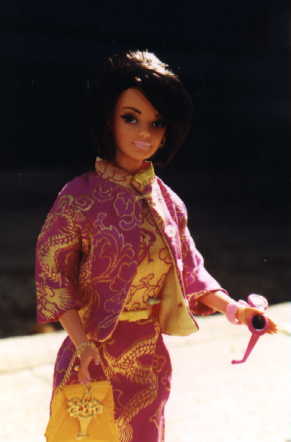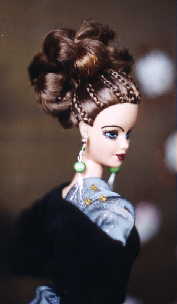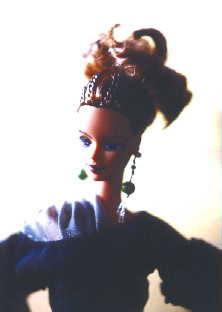|
Page 1
BACKGROUND
Background is your canvas. If you want your
doll to stand out, don't use a busy background, such as your
garden. Finding a suitable background can be difficult, because
you need to find a spot with sufficient light, particularly if
you are not using a flash, which incidentally, I rarely use. Try
to find a background that fits the scale of the doll. Large
leaves and bricks and such make your doll appear small. Ideally,
most of us prefer pictures in which the doll looks like she could
be our size. Setting up a board, or my favorite, a Chinese screen
outside gives you a sufficient light, but not a lot of
distraction. You can tack fabric or nice paper (matte finish to
avoid glare) to the board or screen. Obviously, you can't always
go outside to take your pictures because of the weather or
various other reasons. You can set up your own miniature
photography studio. I use a Chinese screen (alone or covered with
fabric), a high stool on which to put the doll, and a spot light
or two. I set my studio up in front of a window to allow as much
natural light as possible. If you are finding you can't get
enough light, use a pale colored fabric to cover your background,
and it will enhance your light. Blue tends to be a nice
background color to accentuate most dolls.

Also, keep in mind that dark colors may blend
too much with the dolls hair. This is one of my favorite photos
because I like the shadow with underlighting effect, but you
can't see the doll's hair because the background is too dark. Remember, if you want to keep the background out of focus, go to
a lower F-stop to get a shorter range of focus.
LIGHTING
Good lighting is the most tedious and
frustrating part of the photography process, but when you get a
good result, you will be thrilled at how professional your
picture will look. I mentioned before that I rarely use a flash.
Flashes are intended for snapshots and for objects that are
usually at least 6-8 feet away. When you are only a few inches
from your subject, it washes out the light colors. When I don't
have enough light, I move my makeshift studio, or I wait until
another day. If you do use a flash, it's imperative that your
flash can be diverted away from the doll. Swivel the flash so
that it faces 90 degrees away from your doll. You can use a white
poster board off to the side of your studio off which the light
from your flash can bounce.
Natural light is by far the best for enhancing
colors and reducing shadows. However, bright sun may actually be
too much light. Bright overcast days are ideal for photographing
your dolls. Note the difference between these two photos of the
same doll. They were each taken in exactly the same spot on my
porch with the same Chinese screen as a background, but one day
was sunny and the other day was overcast. Pictures taken on a
sunny day will give much higher contrast and may wash out
details, just like a flash. Also note how much more focused the
background is in the sunny picture because of the long range of
focus from using a small aperture.
 
If you can't go outside, or it's too dark to
use natural light, you can achieve sufficient light by using
spotlights that screw into a standard light socket (like a desk
lamp!). Normal light bulbs, unless very high watts, don't provide
enough light. Spotlights are not very expensive. I would
recommend at least 60 watt bulbs. If you can find "full
spectrum" bulbs, they are even better. These can be found at
gardener supply stores or at pet stores that sell reptile
supplies. Most light bulbs give off very yellow light. You may
not be able to tell with your eye, but you can definitely tell in
your photo, when everything is yellow. You can partly overcome
this effect by using a blue background. Full spectrum bulbs have
a little more blue spectrum than regular bulbs. If you use one
spotlight, keep watch on the shadows on the dolls face from her
hair, or her rooted eyelashes, or her nose, or even your head
getting in the way! Two spots can help and you can move them
around for artistic effects. You can also experiment with
different color bulbs, which will wash the entire photo in a
different hue. Try red. It is very interesting. Also keep in mind
that light also reflects from your background onto the doll. Look
how the bluish background made the whole picture blue.

The last, and most important, part of the
lighting is remembering to keep adjusting your F-stop and shutter
speed if needed. Remember that with light alone you can
accentuate parts of your doll and minimize other parts. You can
drastically change the background of your photo by adjusting your
range of focus, which is essentially a lighting adjustment. You
can even try overexposing the picture a little. In this photo, I
adjusted the camera so that there was actually too much light,
which gave a very ethereal high contrast image.

That's it! Load up your camera, and you're off.
Experiment with backgrounds, colors, and poses. Most importantly,
don't be afraid of your camera. Use it as your tool, as an
extension of your doll artistry!




Barbie® is a registered trademark of Mattel®,
Inc. Gene® is a registered trademark of Mel Odom and Ashton Drake.
Candi® is a registered trademark of Hamilton Designs. Tyler Wentworth®
is a registered trademark of the Robert Tonner Doll Company. Any other
dolls mentioned are registered trademarks of their respective owners. This
website and those who maintain it are in no way affiliated with the any
above mentioned parties. The images of the dolls displayed are photos taken
by the author(s) of the article and/or the designer featured. Please do
not remove pictures and/or text from this website without permission of
the webmaster and/or the photographer.
|